Cold-smoked salmon from start to finish (with pics)
Cold-smoked salmon from start to finish (with pics)
-
-
-
-
-
Cold-smoked salmon from start to finish (with pics)
-
Post #1 - June 7th, 2007, 6:29 pmOn another thread about Copper River Salmon, we were discussing cold-smoking, so I thought I'd start a thread documenting my process for making lox. To date, I've probably done this 25 times give or take and each time, the outcome varies slightly. It all started with a recipe from one of the greatest cookbooks I've ever used, Charcuterie, by Michael Ruhlman and Brian Polcyn. Over the batches, I've tweaked the recipe to my liking. But the methods and procedures laid out in the book are remarkably solid and very easy to follow. I've become spoiled because after repeatedly making my own lox with wild salmon, I've yet to find a commercially available version that even comes close. Anyway, here are the basic steps . . .
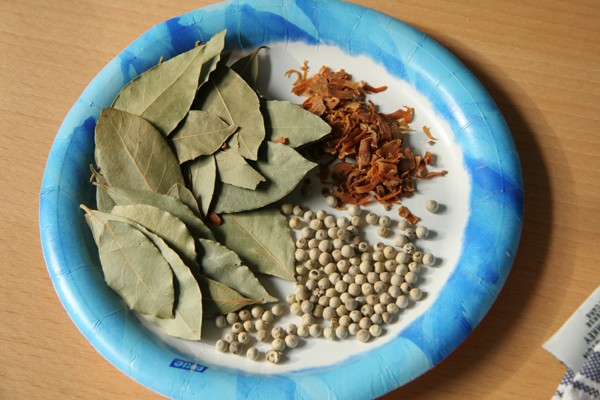
For 5 pounds of fish, I start with 2g of blade mace, 2g of bay leaf and about 20g of whole white pepper. Not pictured here is the process of grinding it fine in an electric coffee grinder.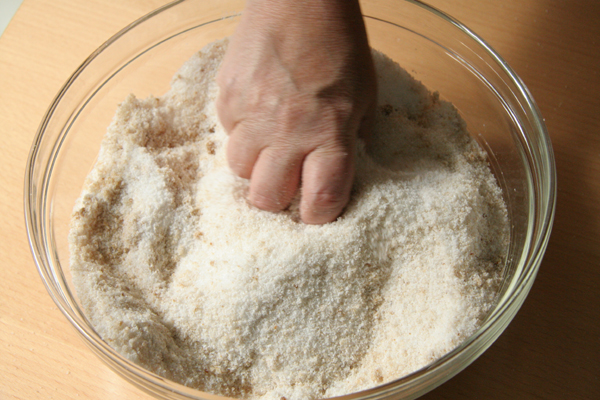
Add the ground spices to 500g kosher salt, 400g granulated sugar, 200g light brown sugar and mix thoroughly.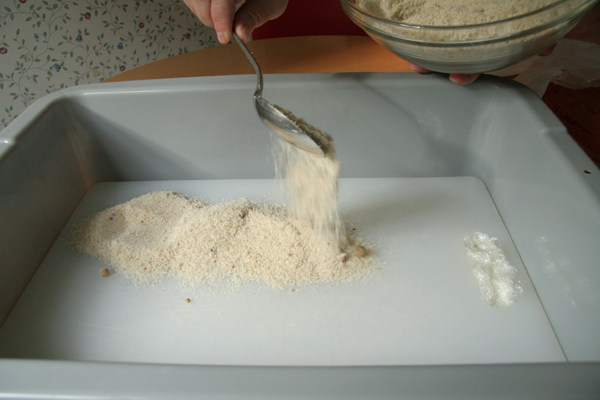
Add about half the cure mixture to the bottom of the curing vessel . . .
. . . making sure to distribute it in an even layer.
Place salmon, with pin bones removed, atop the bottom layer of cure.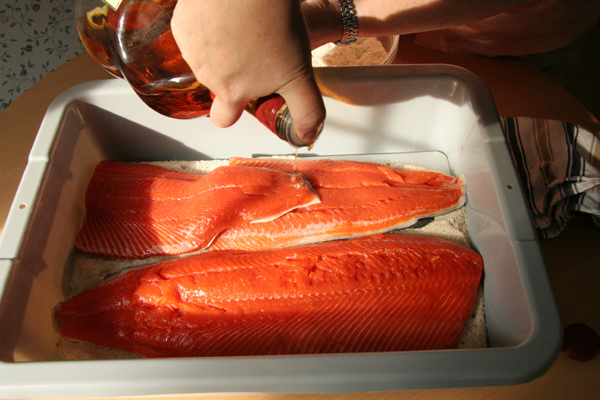
Drizzle some dark rum atop the fish . . . not too much, just enough to moisten it.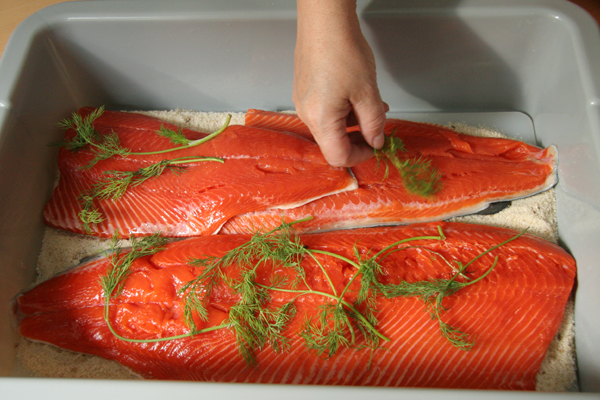
Place dill atop the salmon. I prefer fresh but if you can't get really fresh stuff, you may want to use high-quality, dry dill. If that's the case, add it to cure mixture, with the other seasonings, at the beginning.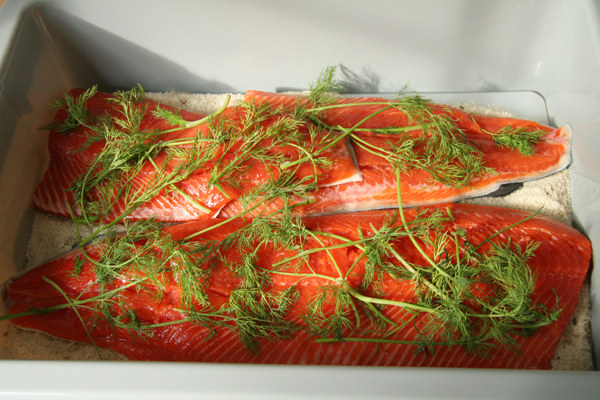
Cover the fish as evenly as possible with the fresh dill.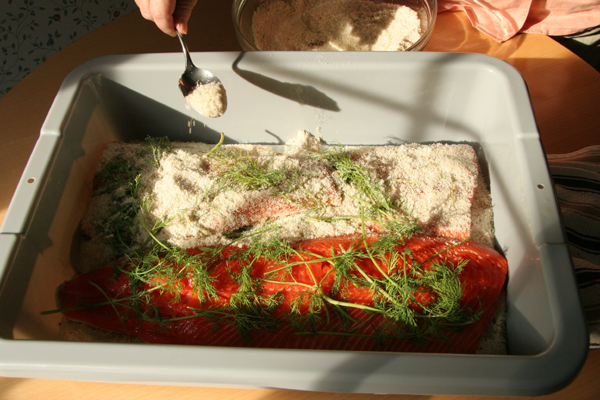
Use the remaining cure mixture to cover the fish.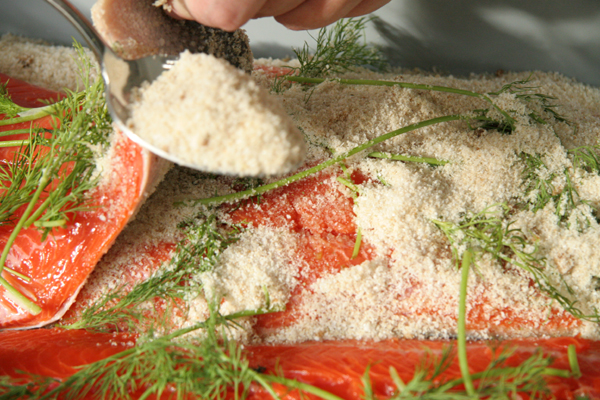
Here, I make sure to place some of the cure mixture between the overlapping sections of salmon.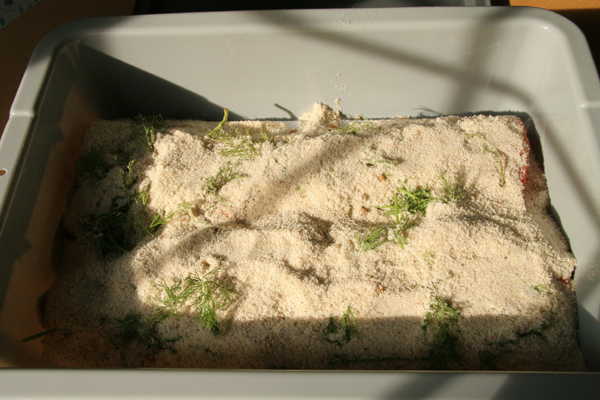
Cover the fish evenly and entirely with the cure mixture.
Place a section of plastic wrap atop the fish to keep everything in place.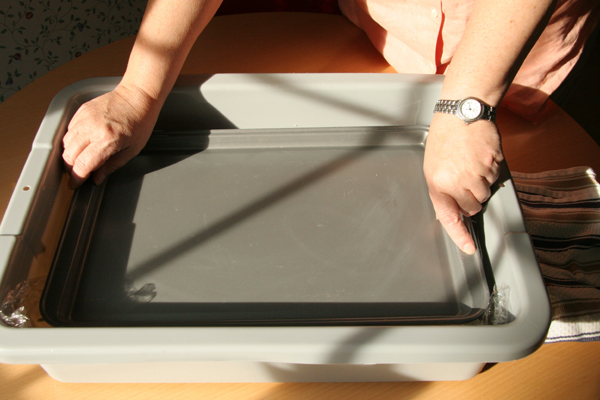
Place a cookie sheet or other appropriate flat object atop the entire deal.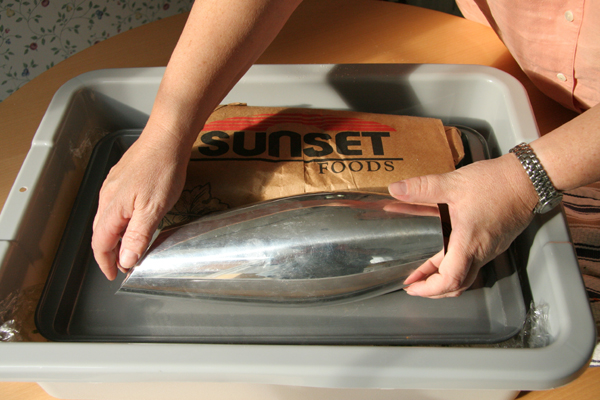
In order to help remove moisture from the salmon, some weight must be placed on top of it.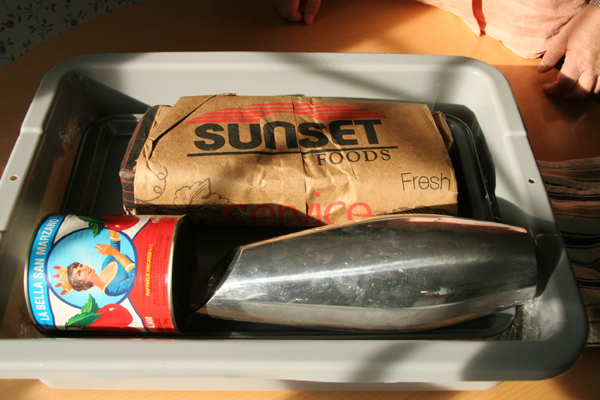
I use a wedding gift, a brick wrapped in a shopping bag and a can of tomatoes to weigh the fish down. I'm not sure these specific items are required but what's important is that they weigh about 18 pounds. For smaller portions of fish, you'd want to use less weight.
Next, the entire tub gets placed in the refrigerator. Through trial and error, I've learned that this much fish (with this thickness) will require between 48 and 72 hours of cure time before it's ready. Again, with smaller quantities of fish, you will reduce the cure time to as little as 24 hours.
The next steps will be a thorough rinse and a brief period of drying which will promote development of a pellicle, or tacky exterior surface, which will help the smoke adhere to the salmon.
=R=By protecting others, you save yourself. If you only think of yourself, you'll only destroy yourself. --Kambei Shimada
Every human interaction is an opportunity for disappointment --RS
There's a horse loose in a hospital --JM
That don't impress me much --Shania Twain
-
-
Post #2 - June 7th, 2007, 6:34 pmRon,
Looks like you're using skin-on salmon; would there be any major difference using skin-off? I assume it might decrease the cure time a little, but are there any other differences?
Great instructional pix, BTW.
-
-
Post #3 - June 7th, 2007, 6:44 pmnr706 wrote:Ron,
Looks like you're using skin-on salmon; would there be any major difference using skin-off? I assume it might decrease the cure time a little, but are there any other differences?
Great instructional pix, BTW.
I honestly don't know. I've cured filets, sides, and whole fish but in all cases the skin has been on. I think your assumption is right. Removing the skin would probably result in a shorter cure. Beyond that, I'm not sure if or how a lack of skin could affect the smoking process. That said, I wouldn't hesitate to try it out with skinless fish, should any come my way.
=R=By protecting others, you save yourself. If you only think of yourself, you'll only destroy yourself. --Kambei Shimada
Every human interaction is an opportunity for disappointment --RS
There's a horse loose in a hospital --JM
That don't impress me much --Shania Twain
-
-
Post #4 - June 7th, 2007, 7:45 pmAt this point -- pre smoke -- you are at gravlax ...
what is the smoke process?
-
-
Post #5 - June 7th, 2007, 10:00 pmSGFoxe wrote:At this point -- pre smoke -- you are at gravlax ...
what is the smoke process?
Exactly.
The smoke process is described briefly in the thread about Copper River Salmon that I linked at the top of this thread. But I will detail it here as it happens on Sunday or Monday. The fish pictured above went into my fridge at about 6 pm this evening, so I'll stay with this particular batch until it's completed.
=R=By protecting others, you save yourself. If you only think of yourself, you'll only destroy yourself. --Kambei Shimada
Every human interaction is an opportunity for disappointment --RS
There's a horse loose in a hospital --JM
That don't impress me much --Shania Twain
-
-
Post #6 - June 11th, 2007, 10:07 pmThis time around, I let the salmon cure for about 68 hours. When I took it out of the fridge, this is what it looked like . . .
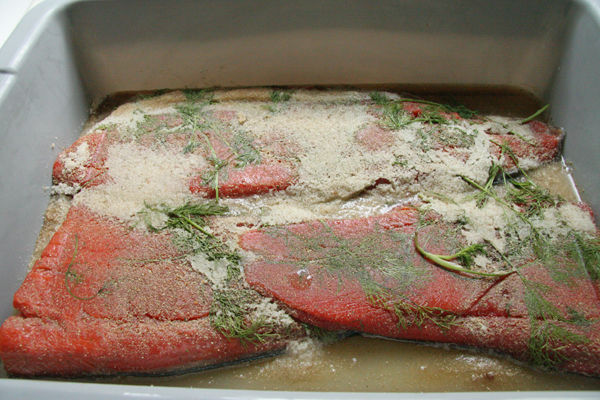
68-hour cured salmon. You can see the rendered moisture at both the top and bottom of the frame.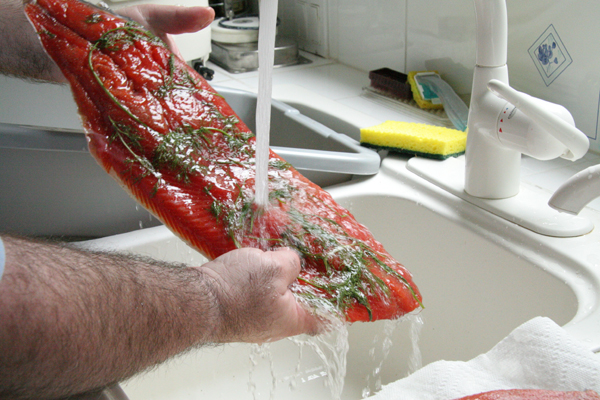
After removing the salmon from the curing vessel, rinse it gently -- and thoroughly -- under coldest possible water.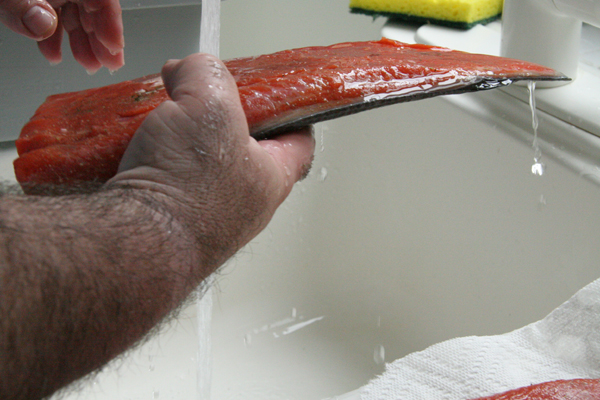
This shot provides a fairly good idea of just how firm the cured fish is. It's still pliable but a bit stiff as well.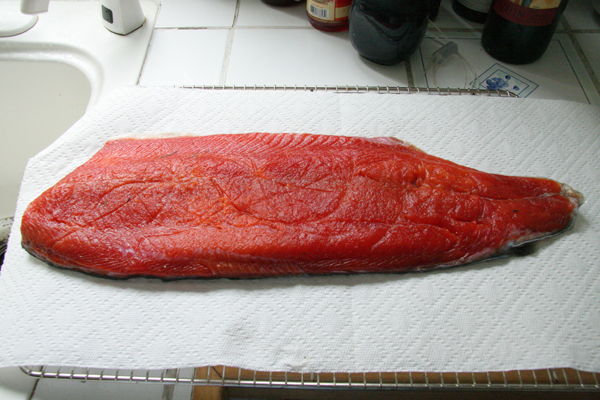
After the rinse is complete, the cured fish is placed on a rack and returned to the fridge. I use a paper towel underneath it just to aid in the drying process.
After the pellicle develops, it's time for smoking. But, if you're not ready to smoke it, you can put the fish in a plastic bag and keep in in the fridge until you are ready (for up to 24 hours or so). I find that doing so doesn't affect the pellicle at all, whereas over-drying can ruin the fish. Generally speaking, a piece of fish this size needs no more than 8 hours of drying time.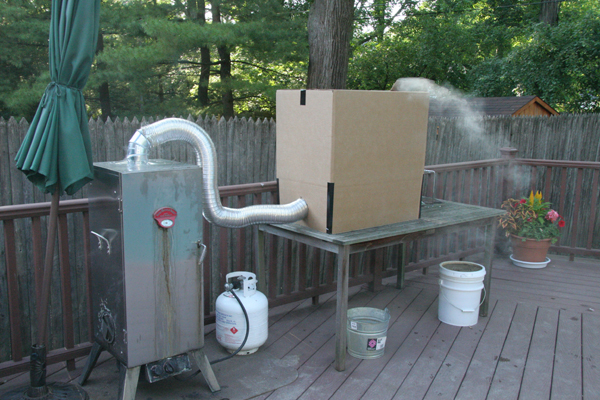
Here is my handy-dandy, cold-smoking rig, aka the cardboard box. A box like this can last a while -- up to 15 uses -- depending on how well you store it between sessions.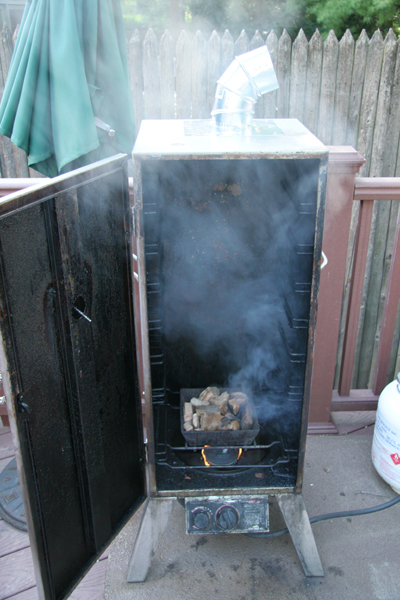
This is just a retro-fitted, propane powered smoker (I added the e-z hook-up chimney). After the wood chunks (don't use chips, they burn too fast) begin to smolder, I cut the gas and let them continue to smolder on their own. Closing the side dampers most of the way keeps the temperature low but also lets the wood continue to burn slowly and produce smoke. It's important to let the wood burn for a while before adding the fish or it can pick up an acrid note. Once the wood's charred thoroughly on its exterior, it's safe to start smoking the fish.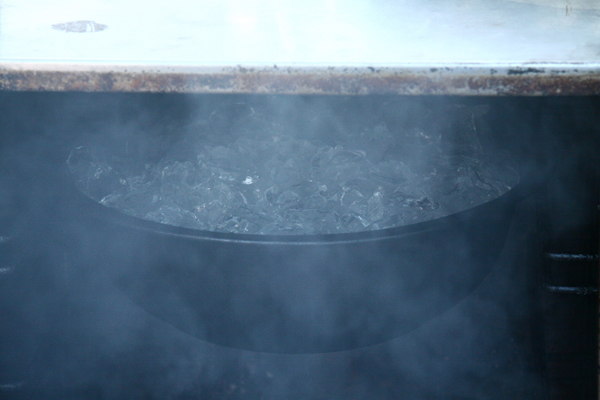
Ice bowl
It's important to keep the smoke under 100 degrees F, so I place a bowl of ice at the top of the smoker cabinet, over which the smoke must pass in its path to the fish. In most sessions, this ice needs to be replaced hourly. If you're smoking in colder weather, you can skip this step entirely.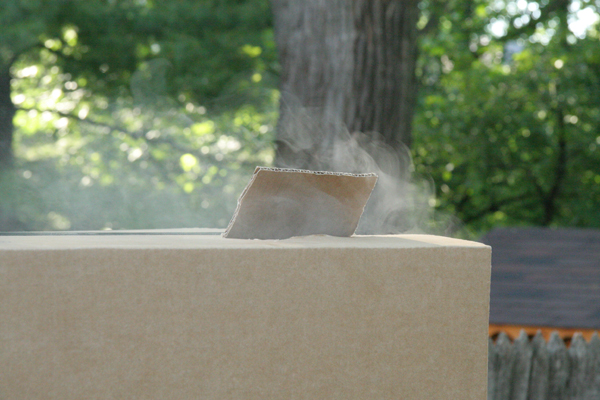
In order to make sure the smoke has an exit route, I cut a flap in the top of my smoker box. It allows the smoke to pass over the fish and exit the smoker chamber without overheating it.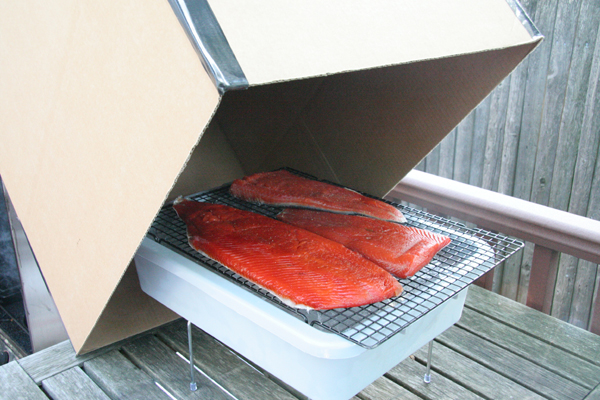
Inside the smoking chamber, the cured fish sits on a rack in a tub of ice. Since the fish resides right on top of the ice, this ice doesn't normally need to be replenished. It's extremely important to keep the fish as cold as possible. Even though the travelled and cooled smoke is no hotter than the air temperature when it reaches the fish, if the air temperture is 80 F, that's not a cold enough environment in which to safely leave the fish. Laying it on the ice ensures that it will stay safely cold throughout the smoking process.
I smoked this batch for about 5 hours over 100% apple wood. After I took it out of the smoker, I put it in sealed bags and placed it in the fridge. I find that the texture of the fish -- and ease of slicing it -- are greatly improved after a night in the fridge.
At this point, it's important to make sure you've got some top-notch bagels and cream cheese on hand because you don't want your home-made wild salmon lox sitting on anything less. In these moments it's especially comforting to know that NYB&B on Touhy is open 24 hours.
Next up, breakfast.
=R=By protecting others, you save yourself. If you only think of yourself, you'll only destroy yourself. --Kambei Shimada
Every human interaction is an opportunity for disappointment --RS
There's a horse loose in a hospital --JM
That don't impress me much --Shania Twain
-
-
Post #7 - June 12th, 2007, 4:39 amThat's a great setup! Thanks for sharing the process in such detail. Can the postcure fish can be eaten as such? I've made gravalax before, and just want to confirm that the cure is this case would yield a gravalax that would be okay if don't manage to smoke it.
I'm still learning my way around the WSM - in Winter I thought I could cold smoke something with a small fire, but even at way below freezing, the damn WSM - bless it's rounded little head - got up to 200º F.
I have thought of getting some ducting and trying the mod shown here or the method described by Alton Brown, but haven't yet.
I'm surprised to learn that the smoke is that hot even in your setup and that requires that much cooling. I'm guessing though the first bowl of ice melts that much because of its location - if it was outside, say in another small box between the smoker and the salmon box, and the smoke passed over it, it may last longer.
Thanks again for the detailed post(s).
-
-
Post #8 - June 12th, 2007, 7:31 amHi,
I have also been looking at attempting to cold smoke. It seems every set up takes on an Rube Goldberg air, though nothing would surprise my neighbors any longer.
I have the sense introducing all the ice to keep things at temperature will also help modulate conditions during summer heat. Is this a reasonable assumption?
When you make that quantity, how long can it be stored? Do you have any storage tips?
Thank you for this learning moment.
Regards,Cathy2
"You'll be remembered long after you're dead if you make good gravy, mashed potatoes and biscuits." -- Nathalie Dupree
Facebook, Twitter, Greater Midwest Foodways, Road Food 2012: Podcast
-
-
Post #9 - June 12th, 2007, 8:20 amCathy2 wrote:I have also been looking at attempting to cold smoke. It seems every set up takes on an Rube Goldberg air, though nothing would surprise my neighbors any longer.
Cathy2,
I have been using the following setup for about a dozen years for cold smoking fish, sausages, etc. I pipe the smoke it produces into my offset pit. No need for ice. I don't remember what I paid, but I'm sure the price was less than half of what they are now asking. You could easily recreate it for far less.
http://www.sausagemaker.com/index.asp?PageAction=VIEWPROD&ProdID=17
Bill/SFNM
-
-
Post #10 - June 12th, 2007, 9:54 amsazerac wrote:That's a great setup! Thanks for sharing the process in such detail. Can the postcure fish can be eaten as such? I've made gravalax before, and just want to confirm that the cure is this case would yield a gravalax that would be okay if don't manage to smoke it.
Yes, as mentioned upthread, it's basically gravlax before smoking and it can be eaten as is.sazerac wrote:I'm surprised to learn that the smoke is that hot even in your setup and that requires that much cooling. I'm guessing though the first bowl of ice melts that much because of its location - if it was outside, say in another small box between the smoker and the salmon box, and the smoke passed over it, it may last longer.
Well, I'm not sure that it does. By the time the smoke reaches the box, it's basically reached equilibrium with the air temperature. But, since there is a risk of botulism, even with cured fish, if it is not kept cold enough, I take extra precautions. IMO, an ounce of prevention is worth a pound of cure. Or in this case, a couple 8-pound bags of ice placed under the fish go a long way in alleviating my safety concerns.
=R=By protecting others, you save yourself. If you only think of yourself, you'll only destroy yourself. --Kambei Shimada
Every human interaction is an opportunity for disappointment --RS
There's a horse loose in a hospital --JM
That don't impress me much --Shania Twain
-
-
Post #11 - June 12th, 2007, 10:06 amCathy2 wrote:I have also been looking at attempting to cold smoke. It seems every set up takes on an Rube Goldberg air, though nothing would surprise my neighbors any longer.
I delight in the thought that my smoking could be disturbing (some of) my neighbors. It makes up for the constantly barking dogs, floodlights shining in my house at all hours of the night, etc. The folks next door to us are cool, so I always share my finished product with them.Cathy2 wrote:I have the sense introducing all the ice to keep things at temperature will also help modulate conditions during summer heat. Is this a reasonable assumption?
I think it is. And again, the ice is used only in part to help cool the smoke. As I mentioned above, fish -- even when cured -- can lead to especially dangerous food safety problems if not kept cold enough, so the ice -- especially under it -- helps mitigate the likelihood of these problems occuring.Cathy2 wrote:When you make that quantity, how long can it be stored? Do you have any storage tips?
Without doing anything special, the fish will keep for about a week to 10 days under refrigeration in a regular baggie. I always slice it as I go, which helps extend the shelf life a bit. Distributing finished product to friends and family is also a helpful outlet.
But, I also have a foodsaver, which comes in very handy in situations like these. I've found that a vacuum-sealed package of finished lox stores well in the freezer for at least a few weeks (I've never stored one longer than a month). To thaw, merely place the frozen packet into cold water until it's soft. Vacuum sealing followed by refrigeration can also extend the shelf life to about 14 days, minimum.
=R=By protecting others, you save yourself. If you only think of yourself, you'll only destroy yourself. --Kambei Shimada
Every human interaction is an opportunity for disappointment --RS
There's a horse loose in a hospital --JM
That don't impress me much --Shania Twain
-
-
Post #12 - June 12th, 2007, 8:11 pmCathy2 wrote:Hi,
I have also been looking at attempting to cold smoke. It seems every set up takes on an Rube Goldberg air...
You need a smoke pistol. This is a really clever device which allows you to turn almost any smoker, grill or cardboard box into a cold smoker with a minimum of fuss. Essentially an "L" shaped tube fitted to an air pump and fueled by a proprietary wood pellet cartridge (many types of wood are offered) , this contraption hangs outside the smoking chamber and feeds smoke in thru a 1/2" hole. Each cartridge burns for nearly three hours. I'm not sure this will yield the same results as RS's meticulous process above, but it works very well and is as easy as can be. Does hot smoking too! Check out their website at smokepistol.com.Lacking fins or tail
The Gefilte fish
swims with great difficulty.
Jewish haiku.
-
-
Post #13 - June 12th, 2007, 8:46 pm
You had me right up to the words, "proprietary wood pellet cartridge".kuhdo wrote:You need a smoke pistol. This is a really clever device which allows you to turn almost any smoker, grill or cardboard box into a cold smoker with a minimum of fuss. Essentially an "L" shaped tube fitted to an air pump and fueled by a proprietary wood pellet cartridge (many types of wood are offered) ...
-
-
Post #14 - June 12th, 2007, 11:01 pmd4v3 wrote:
You had me right up to the words, "proprietary wood pellet cartridge".kuhdo wrote:You need a smoke pistol. This is a really clever device which allows you to turn almost any smoker, grill or cardboard box into a cold smoker with a minimum of fuss. Essentially an "L" shaped tube fitted to an air pump and fueled by a proprietary wood pellet cartridge (many types of wood are offered) ...
What? You don't know from proprietary wood pellet cartridges?
Actually, these look sort of like a toilet paper roll with a fuzzy cap which is what you light....odd but it works really well.Lacking fins or tail
The Gefilte fish
swims with great difficulty.
Jewish haiku.
-
-
Post #15 - June 15th, 2007, 9:27 amSorry for the delay in finishing this up. It's been a long week, which has included computer problems, sitting in lots of traffic and intense busy-ness at work. Still, as the saying goes, there's always time for lox and bagels


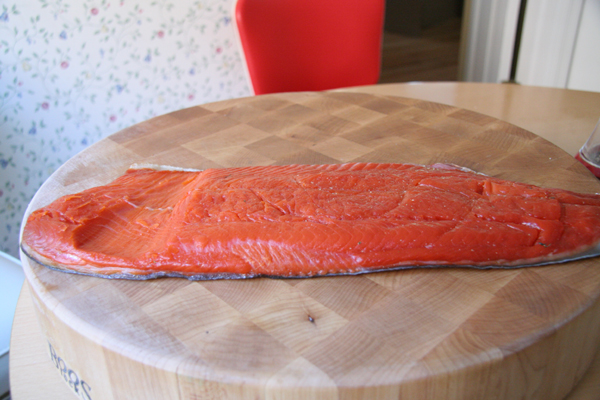
Partially sliced side of cold-smoked salmon.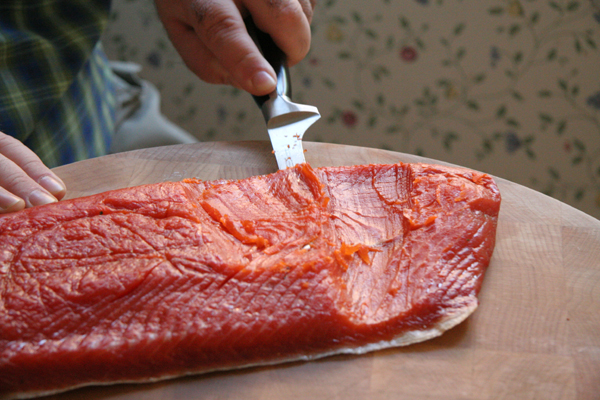
I usually slice as I go, using a boning knife. For a party situation, I'm more likely to remove the skin and slice the entire side at one time. But, it keeps better if left whole.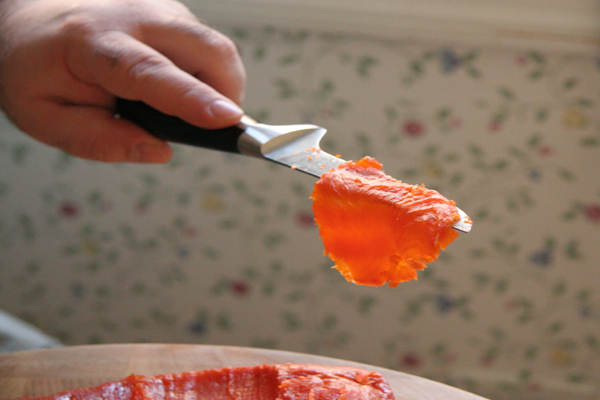
Ideally (for my taste), the slices are very thin. You can't actually see light through them but it's close.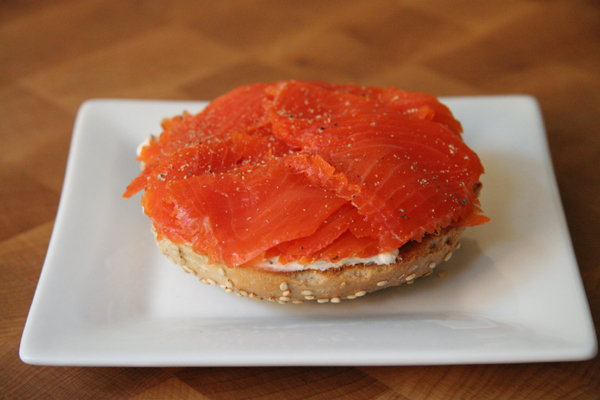
Serving suggestion
My usual mode of delivery is on a toasted sesame bagel (from NYB&B on Touhy) with some chive cheese from Once Upon A Bagel in Highland Park and some cracked black pepper. I really like the way the toastiness of the bagel and the sesame combine with the smokiness of the fish. For me, there's enough onion flavor in the cream cheese, so I rarely add it. If I had access to worthy tomatoes, I'd add them. But unless they're great, they just ruin things.
=R=By protecting others, you save yourself. If you only think of yourself, you'll only destroy yourself. --Kambei Shimada
Every human interaction is an opportunity for disappointment --RS
There's a horse loose in a hospital --JM
That don't impress me much --Shania Twain
-
-
Post #16 - June 15th, 2007, 2:20 pmRonnie,
That's some of the richest looking lox I have ever seen. Nice job!Steve Z.
“Only the pure in heart can make a good soup.”
― Ludwig van Beethoven
-
-
Post #17 - June 19th, 2007, 7:29 pmwho has the nice smooth arms in the pics at the beginning?
i've tasted ron's lox, they are the best ever.
-
-
Post #18 - June 20th, 2007, 9:23 amRon, thanks for sharing. Excellent pictures.
For those who want something similar, but don't have the setup (yet) to cold smoke the salmon, here are some other ways to finish the salmon:
1. Don't smoke it at all and you have gravlax, as discussed earlier.
2. "hot smoke" the salmon. Lacking a cold smoker, I've smoked the cured salmon at about 200-250 degrees, until it reaches an internal temperature of about 140 or so. This is a vastly different product than what Ronnie made, but it still retains a smoky, cured flavor. I think you'd want to eat this within a few days of cooking.
3. Grill the salmon as you would fresh (i.e. uncured) salmon. Again, this is a vastly different product, but it lets you experience the cured salmon without going through the cold smoke process.
Before people jump all over me, I want to emphasize that these procedures don't give you anything resembling lox. They are different dishes. But, they are great dishes if you want to experiment with curing salmon but aren't ready to buy or make a cold smoker.
-
-
Post #19 - June 20th, 2007, 10:20 amDarren72 wrote:Ron, thanks for sharing. Excellent pictures.
2. "hot smoke" the salmon.
3. Grill the salmon as you would fresh (i.e. uncured) salmon.
It may just be me, but the salt level in the cure of the typical cold-smoked salmon recipe is too high if I end up cooking it and eating it hot. For me, the taste of salt is much stronger in a food that is heated vs. the same food served cold.
I hot smoke and grill salmon frequently, but with much lower salt levels.
Maybe it's just me.
-
-
Post #20 - June 24th, 2007, 10:10 amRonnie: nice praise from Michael Ruhlman about this thread. He's correct, your posts are an excellent description of the process.
-
-
Post #21 - July 2nd, 2007, 8:30 pmLTH,
In addition to the company, food and general merriment last evening at the LTH event Ronnie_Suburban and Cathy2 arranged at Casa de Isaac I was fortunate enough to be the recipient of some of the cold smoked salmon depicted in this thread.
Kiss of smoke, hint of sweet, rich, luxurious, silky.
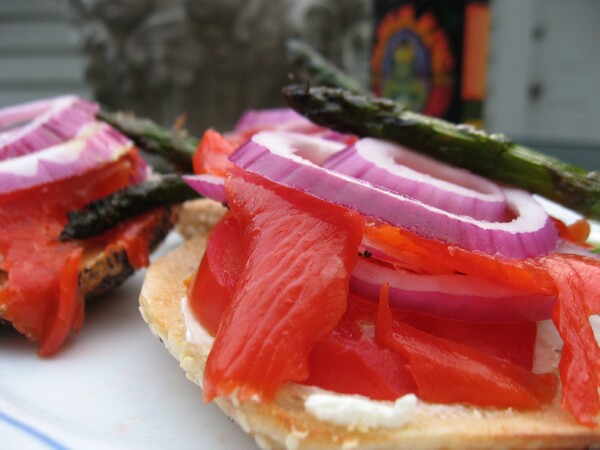
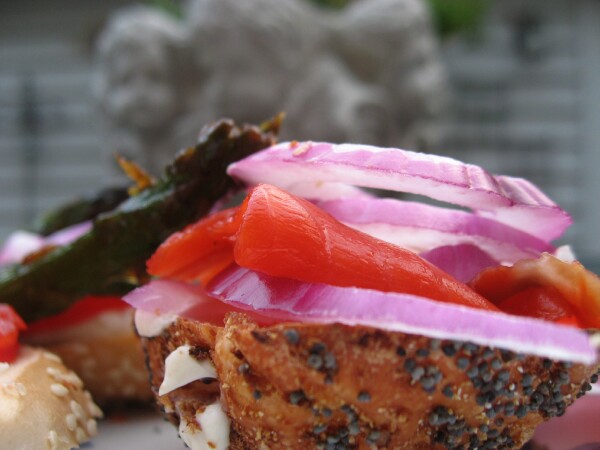
Thanks Ronnie_S.
Enjoy,
Gary
-
-
Post #22 - July 8th, 2007, 6:51 amronnie_suburban wrote:I thought I'd start a thread documenting my process for making lox.
Wow, Ron, that is beautiful, beautiful smoked fish. Gorgeous. And I'm sure it tastes as good as looks.
So I really hate to bring up what I know many will think is quibbling ... but my longtime friend Moshe, who has made this something of personal campaign, would never forgive me if I didn't. Moshe's motto: "Save the lox! Nova difference."
Moshe is deeply concerned that real lox is disappearing because people don't understand what it is.
What you have made is Nova, not lox. Real lox is very salty, oily, cured salmon. Traditionally, it was not smoked. This article explains the difference.The New York Times wrote:Mark Russ Federman, the 57-year-old owner, grandson of the original Russ, pointed to a meaty, deep pink chunk of fish: lox, which in his store means the rich, brine-cured belly of a wild Pacific salmon. "That's where it all started," he said.
But today, lox accounts for only a small fraction of his salmon sales.
"People use lox as a general term — bagel and lox — but what is traditional and genuine lox is not smoked salmon at all," said Mr. Federman's daughter Niki, who also works at the shop. "It is a salmon cured in salt brine. No refrigeration needed. When people come into the store, they ask for lox, and we say, 'Are you sure?' "
Here is a recipe:- Isabella Bouer's Lox
1 - qty of VERY fresh, VERY fatty (with whole skin) salmon
1 - large earthenware crock (or wooden keg)
Kosher Salts (or rock salt)
Qty of clear flavorless oil comparable to the qty of salmon
- Skin the salmon keeping the skin as whole as possible.
- Cut the salmon meat into thin slices.
- Within the crock, (or keg), lay down a layer of salt to cover evenly.
- Place one side of the salmon skin scale side up flat onto the salt layer.
- Drizzle the oil lightly over the skin until shiny.
- Lay one salmon slice atop the oiled skin.
- Drissle the oil lightly over the salmon slice until shiny.
- Layer the salts thinly atop the salmon slice to cover.
- Repeat the layers as above alternating salt, salmon, oil for all remaining
slices.
- Before adding the final layer of salts, lay the other side of the skin
scale side up atop the oiled salmon.
- Drissle with oil until shiny.
- Layer salts atop the final layer of skin to cover.
- Cover entire crock (or keg) with multiple layers (3-4) of plastic wrap
- Weigh down the top of the sealed crock (or keg) with heavy stones.
- Store in a cool place 2 weeks prior to usage.
- Eat when ready!~
NOTE: This will keep almost indefinitely, however, refrigeration is
recommended.
This results in a much saltier, somewhat fishier-tasting product, and I'm sure most people will prefer your cold-smoked salmon.
Edited to fix link to NY Times articleLast edited by LAZ on July 9th, 2007, 1:15 pm, edited 2 times in total.
-
-
Post #23 - July 8th, 2007, 9:36 amThanks, LAZ, for the clarification. You're right in that I've always associated lox with smoke. The "true" lox you describe here is also something I've made in the past (using oil and salt instead of a dry cure) but the idea of adding an 'outside' oil to a really delectable piece of fatty wild salmon just didn't make sense to me and I felt it actually obscured the flavor of the fish a bit. Nonetheless, I'm grateful for the additional information, which will definitely come in handy down the road.
I always figured there were other differences between what I've been producing and "true" lox, which is why I generally refer to it as cold-smoked salmon. In my mind, this stuff doesn't really become 'lox' until it's sitting on a bagel.
=R=By protecting others, you save yourself. If you only think of yourself, you'll only destroy yourself. --Kambei Shimada
Every human interaction is an opportunity for disappointment --RS
There's a horse loose in a hospital --JM
That don't impress me much --Shania Twain
-
-
Post #24 - July 9th, 2007, 1:19 pmronnie_suburban wrote:the idea of adding an 'outside' oil to a really delectable piece of fatty wild salmon just didn't make sense to me
In a way, it's comparable to confit, which was also originally a preservation technique.
-
-
Post #25 - July 9th, 2007, 2:06 pmGrowing up in a New York suburb, the delis would have "belly" lox and "nova." Belly lox was always much saltier. This discussion confirms what I'd always thought, whcih was that belly lox was not smoked ("real" lox?), and nova was the smoked stuff. I wonder where the "belly" part of the name came from?
Jonah
-
-
Post #26 - July 9th, 2007, 2:16 pmLAZ wrote:ronnie_suburban wrote:the idea of adding an 'outside' oil to a really delectable piece of fatty wild salmon just didn't make sense to me
In a way, it's comparable to confit, which was also originally a preservation technique.
I guess but my few attempts at confit have involved preserving duck in its own fat, not an outside fat.
=R=By protecting others, you save yourself. If you only think of yourself, you'll only destroy yourself. --Kambei Shimada
Every human interaction is an opportunity for disappointment --RS
There's a horse loose in a hospital --JM
That don't impress me much --Shania Twain
-
-
Post #27 - July 9th, 2007, 2:31 pmJonah wrote:Growing up in a New York suburb, the delis would have "belly" lox and "nova." Belly lox was always much saltier. This discussion confirms what I'd always thought, whcih was that belly lox was not smoked ("real" lox?), and nova was the smoked stuff. I wonder where the "belly" part of the name came from?
Jonah
Those are not necessarily New York terms. Those same designations are used in the delis here as well.Steve Z.
“Only the pure in heart can make a good soup.”
― Ludwig van Beethoven
-
-
Post #28 - July 9th, 2007, 2:32 pmronnie_suburban wrote:I guess but my few attempts at confit have involved preserving duck in its own fat, not an outside fat.
Yeah, but think what a waste it would be to render such a salmon for its fat....
-
-
Post #29 - July 13th, 2007, 5:43 pmBTW, Ronnie -


-
-
Post #30 - February 10th, 2009, 10:04 amLooks great, I'm going to cure some salmon today with some lemon, orange rind, cracked black pepper and fennel. But I am going to to use 2.5% sugar and 4.5% salt which is much saltier than your version. I'll see how it turns out.

